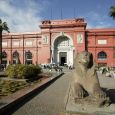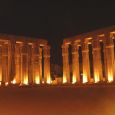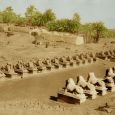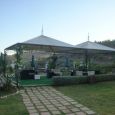Luxor
Advertisement
By Plane
Luxor International Airport (ICAO: LXR) is a destination for flights on several European and Middle Eastern routes, as well as the main southern hub for domestic flights within Egypt.
Internal flights (duration approx. 1 hr) from Cairo to Luxor are maintained by Egyptair [1] and cost about $120 for a return trip ticket.
Direct charters from Europe (London Gatwick, for example) are common in the winter high season. From the airport in Luxor, you will probably take a shuttle provided by your hotel. Note that the Airport in Luxor is very small, and getting luggage off the belt is a challenge.
EgyptAir also arranges day trips from Cairo which is an easy way for those who can stand long days to cover the main attractions of Luxor. Taxis are in abundance everywhere for local transportation.
By Train
For those unwilling to purchase an expensive plane ticket, who have more time in which to travel and / or who wish to see more of the country, train travel to Luxor is a great and amazingly inexpensive option.
By Boat
There are boat trips from Luxor to Aswan and also on Lake Nasser to Abu Simbel. These are reportedly the most pleasant and interesting way to get there if you have the time and money. A felucca cruise on the Nile is a great option for those with more time and less money. The train is a close second and much faster.
By Bus
Buses leave regularly from behind the Luxor Temple, to most major cities. For connections to Aswan and Cairo, the train is recommended, but it is a good alternative to get to Sinai (via Hurghada--Sharm el Sheik, or over the Suez canal).
Museum of Ancient Egyptian Art
From the entrance hall a short flight of steps leads to the ground floor. Notable items here include an alabaster group depicting Amenophis III under the protection of the crocodile god Sobek (from Dahamsha),
Temple of Luxor
At the south end of the modern town, close to the Nile, stands the imposing Temple of Luxor, and within to the northeast, the little Mosque of Abu el-Haggag, a much revered Muslim holy man. The temple was built by Amenophis III on the site of an earlier sandstone temple and was known to the Egyptians as Apet Amunresyet, the "Southern Harem of Amun". It was dedicated to Amun, his consort Mut and their son the moon god Khons. Like all Egyptian temples, it comprised the chapels of the deities with their vestibules and subsidiary chambers, a large hypostyle hall and an open peristyle court, which was approached from the north by a great colonnade.
The temple was 623ft/190m long and 180ft/55m wide at its broadest part Opposite the temple was a granite chapel built by Tuthmosis III. During Amenophis IV's religious revolution the figures and names of Amun were obliterated and a sanctuary of the Aten, the Sun, was built near the temple. When Tutankhamun moved the royal residence back to Thebes he had the walls of the colonnade embellished with reliefs, in which Horemheb later substituted his own names for those of his predecessor. The Temple of the Aten was destroyed, and in the reign of Sethos I the reliefs of Amun were restored. Ramesses II, the great builder, also extended the Temple of Luxor, adding a new colonnaded court at the north end, usurping Tuthmosis III's chapel and replacing the old reliefs by new ones, and erected a massive pylon with its doorway adjoining Tuthmosisill's chapel. These later structures involved a slight displacement of the axis of the temple, and increased the total length to 583ft/260m. Thereafter the temple underwent little alteration. In Christian times it was converted into a church.
Head of Sesostris III
Notable items here include a head of Sesostris III in reddish granite (found at Karnak in 1970), a statue of Tuthmosis III in greenish graywacke (from Karnak), a bust of Amenophis 11 wearing the double crown (reddish granite; from Karnak), a large and historically important limestone stela celebrating Kamose's victory over the Hyksos (from Karnak) and a squatting figure of Yamu-Nedieh in black granite (from Qurna).
Colossal Statues of Ramesses II
On the south side of the Great Court of Ramesses II, between the front columns, are colossal statues of Ramesses II, with an average height of 23ft/7m, all of red granite except one which is of black granite. The finest of these figures, whose crown, carved from a separate block, has fallen off, was 17.5ft/5.30m high; on the base and the apron are carved the King's names. On each side of the south doorway is a colossal seated figure of the King with the Queen seated on his right.
October - March





